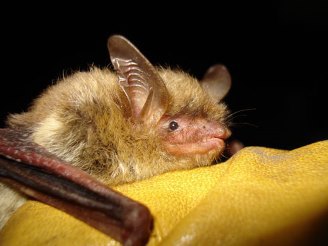Michigan DNR applauds USFWS northern long-eared bat decision
Michigan Department of Natural Resources sent this bulletin at 04/01/2015 11:07 AM EDT|
Ruling provides maximum benefit to the species, with reasonable limits on regulations. |
 |
 |
 |
 |
 |
Press Release
FOR IMMEDIATE RELEASE
April 1, 2015
Contact: Dan Kennedy, Michigan DNR endangered species coordinator, 517-284-6194
or Ed Golder, Michigan DNR public information officer, 517-284-5815
Michigan DNR applauds U.S. Fish and Wildlife Service’s northern long-eared bat decision Today the U.S. Fish and Wildlife Service (USFWS) announced that it is listing the northern long-eared bat as a threatened species with an interim 4(d) rule under the Endangered Species Act. The interim 4(d) rule provides maximum benefit to the species while also providing reasonable limits to regulations.
Today the U.S. Fish and Wildlife Service (USFWS) announced that it is listing the northern long-eared bat as a threatened species with an interim 4(d) rule under the Endangered Species Act. The interim 4(d) rule provides maximum benefit to the species while also providing reasonable limits to regulations.
“Michigan and other states worked collaboratively to provide critical information as the U.S. Fish and Wildlife Service evaluated the status of the northern long-eared bat,” said Keith Creagh, Michigan Department of Natural Resources (DNR) director.
“The decision to list the bat as threatened with an interim 4(d) rule represents a biologically sound determination that will address the conservation needs of these bats in the specific areas of Michigan where they are found, while providing flexibility for those who live and work within the bats’ range,” Creagh added. “Looking ahead, we expect to continue working closely with the U.S. Fish and Wildlife Service as we focus on finding the right solutions to this conservation challenge.”
The Michigan DNR and other Midwestern state natural resource agencies support the U.S. Fish and Wildlife Service’s interim 4(d) rule because it allows states to conserve and protect the northern long-eared bat while continuing normal forest management activities and routine right-of-way maintenance. The decision should reduce the potential economic impact of the northern long-eared bat listing to the forestry and transportation industry.
Populations of northern long-eared bats have drastically declined due to white-nose syndrome, which has killed an estimated 5.5 million bats in the Northeast, Southeast, Midwest and Canada. The fungus that causes this disease thrives in low temperatures and high humidity – conditions commonly found in caves and mines where northern long-eared bats hibernate. In Michigan, white-nose syndrome has been confirmed in eight counties: Alpena, Dickinson, Keweenaw, Mackinac, Marquette, Ontonagon, Clare and Manistee.
In Michigan, the interim 4(d) rule allows certain activities that are considered a conservation benefit to northern long-eared bats as long as these activities:
- Occur more than .25 miles from a known, northern long-eared bat occupied hibernacula.
- Avoid cutting or destroying known, northern long-eared bat occupied maternity roost trees during the pup-rearing season (June 1-July 31).
- Avoid clearcuts within .25 miles of known, northern long-eared bat occupied maternity roost trees during the pup-rearing season (June 1-July 31).
These conservation measures are designed to protect bats when they are most vulnerable, including when they occupy hibernacula and during the two-month pup-rearing season from June through July. The greatest potential restrictions would be during these months, with reduced restrictions at all other times.
Activities that are allowed when the above listed measures are followed include:
- Forest management.
- Maintenance and expansion of existing rights-of-way and transmission corridors.
- Prairie management.
- Minimal tree removal projects.
- Removal of hazardous trees for protection of life and property.
- Removal of northern long-eared bats from human structures.
- Research-related activities.
Over the past 18 months, the Michigan DNR has provided leadership on this issue by:
- Nationally, working with regional forestry and wildlife state agency associations to develop reasonable and appropriate conservation measures that benefit the northern long-eared bat and allow for sustainable natural resource management in Michigan.
- Regionally, assisting the Midwest Association of Fish and Wildlife Agencies and the Northeastern Area Association of State Foresters with developing and submitting scientifically sound recommendations to the U.S. Fish Wildlife Service on the proposed northern long-eared bat listing.
- Leading the effort (sponsored by the Midwest Association of Fish and Wildlife Agencies) to convene a three-day, state-led northern long-eared bat conference that helped state natural resource agencies discuss scientifically based recommendations for the USFWS on the northern long-eared bat final listing decision.
The U.S. Fish and Wildlife Service is reopening the public comment period April 2, 2015, to continue evaluating the interim 4(d) rule. A final decision on the interim 4(d) rule is expected by December 2015.
To learn more about the northern long-eared bat and the final listing determination, visit the USFWS website http://www.fws.gov/midwest/endangered/mammals/nlba/.
To learn more about the history and background of white-nose syndrome in Michigan, visit the DNR website www.michigan.gov/wns.
/Note to editors: An accompanying photo of the northern long-eared bat is available below for download. Photo credit David Redell/Wisconsin DNR/